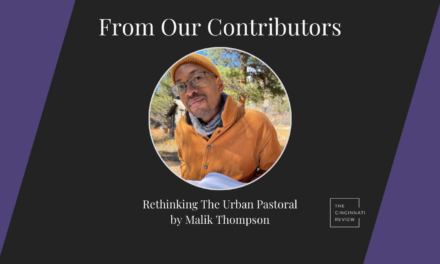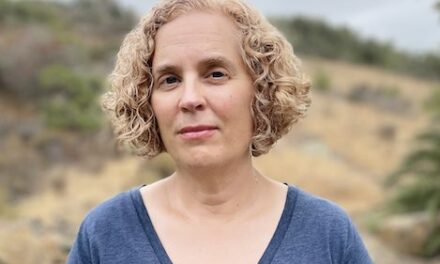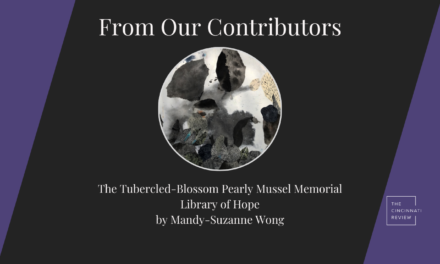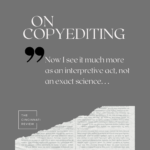 Sara Watson: Since my MFA years at Chatham University, a program grounded in themes of nature and travel writing, I’ve developed a particular interest in poetry of place. So much of my own work looks inward, or, at its most ambitious, reaches out from my body toward another. I love it when other poets are able to look up, to look around, to record a world outside themselves. The contributors below have taken their inspiration from a number of locales, using place to investigate themes of home, family, history, and identity.
Sara Watson: Since my MFA years at Chatham University, a program grounded in themes of nature and travel writing, I’ve developed a particular interest in poetry of place. So much of my own work looks inward, or, at its most ambitious, reaches out from my body toward another. I love it when other poets are able to look up, to look around, to record a world outside themselves. The contributors below have taken their inspiration from a number of locales, using place to investigate themes of home, family, history, and identity.
Susan Davis on “Bertie Mae”: The manuscript from which these poems have been taken is about houses and how people relate to them. How do they feel about the private and public parts, other people’s houses, empty houses telling wordless stories, ownership, centeredness, towns/villages/suburbs and cities, and how they shape the types of dwellings people call home? How did house-building develop in America? The “Bertie Mae” poems are specifically my mother’s stories, starting in 1921 on a farm, ending with a widow alone in a house filled with the memory of her husband. They are snapshots of her along that life path. Although the poems have an elegiac quality, she is very much alive at ninety-three, filling us all with admiration, and challenging me to think of how I will leave myself to my own children.
James Kimbrell on “Pluto’s Gate: Mississippi”: I ran across an article in 2013 about the discovery of an ancient cave opening in Hierapolis, Turkey, believed by archeologist Francesco D’Andria to be the famed gates of the underworld, replete with toxic mist capable of killing any animal that had the ill fortune to breathe there. We all have our own hells with their own gates. Naturally, I started thinking about my home state of Mississippi, and about how far the state—given its history of poverty and racism—has come, and how far it hasn’t. More than most poems I’ve written, I felt that this poem was out of my control, a feeling like being a ventriloquist’s dummy, my mouth getting worked by some unknown voice, both scary and one hell of a rush. In short, this poem is a love letter to Mississippi, and to my friends there, especially to poet C. Leigh McInnis, whom I’ve known since we were both teenagers in the Mississippi Army National Guard, writing poems on legal pads with our desk drawers open so that if anybody walked in our office, we could close the drawers in one quick motion and appear to be hard at work on matters of military readiness.
Wayne Miller: I wrote “Marriage” in Belfast, Northern Ireland, where my wife and two-year-old daughter had accompanied me for six months while I was teaching at Queen’s University on a Fulbright. We were living in faculty housing—a narrow, street-level apartment across from campus—and it poured freezing rain for the first three months we were there. Also important: My wife and I were in our eleventh year as a couple (and second year with a child)—a point in a relationship pretty much no one can imagine when they first get together. Probably because of the weather-induced confinement of those first three months, I kept dreaming myself into different, exotic locales, which was ironic since we’d just traveled all that way to be in Belfast—where, of course, I always woke to find myself. The way my mind kept reaching out and returning home—that lassoing—seemed to me a good description of how a relationship comes to operate ten (or more) years in. As soon as I found the rhyming form, the poem took off.
Mai Der Vang: “Cipher Song” emerged from my attempt to explore and reconcile the lack of an official literary history within my Hmong culture. It’s the idea of writing about not having writing. Yet how does one even begin to tackle such a daunting and elusive past? It’s overwhelming, to say the least, especially given that this history carries profound implications for a new generation of Hmong-American writers like myself, who are seeking to shape a literary identity. In this poem, I try to explore how something as simple as a jacket, along with other items of clothing, can have attached to it centuries of literary and historical documentation. As an oral culture, the Hmong fled southern China in the mid-1800s as a result of persecution, and many migrated into Laos along with other parts of Southeast Asia. Yet just before fleeing, the women secretly embroidered colorful symbols and patterns onto their clothes to represent what the Hmong had been through so they would not forget their history. Much of this traditional clothing is still worn today in our culture.
“Toward Home” is a poem in search of the idea of home, which, to me, is also the search for origin. I feel like I’m constantly digging toward the past, trying to find vestiges of my Hmong cultural history because so little of it was documented. While this poem does not explicitly take up that notion, it still tries to convey the sense of searching for something unexplainable only to be left feeling vulnerable. Craft-wise, I was obsessed at the time with pairing odd objects together, things that just didn’t make any sense. I seem to always be journeying backward, and so much of that internal process can be confusing and bewildering yet still lead to some bizarre and beautiful discoveries, like an oryx as a window, or a lighthouse inside a cave.










